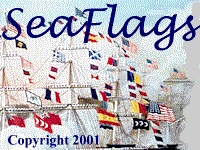
 |
President, Vice President, and Cabinet Officers |
Navy Regulations provide for the display aboard ships of the Navy of the personal flags of senior officials of the United States Government, down to the rank of assistant secretary, who are in the Navy's organizational chain of command: the President and Vice President, officials of the Office of the Secretary of Defense, and those of the Navy Department. These flags are flown at the truck of the aftermost mast while the official is aboard; if the vessel being visited is a flagship, the admiral's flag or the commander's command pennant is shifted to the starboard yardarm of the same mast. If more than one official is visiting, only the flag of the seniormost official is displayed.
When a senior official formally visits a Navy or Marine Corps shore installation, his or her flag is flown from the point where the installation commander's flag normally flies, usually at the starboard yardarm of the main flagmast. For flying aboard ship, or from a pole equipped with halyards ashore, these flags come in two sizes based on the size of the ship or pole: 41 by 61.5 inches or 22 by 32 inches. When mounted on a staff for indoor display or parade use, these flags are 52 x 66 inches with a 2.5 inch fringe around the top, fly end, and bottom, and with an eight foot six inch cord with tassels attached to top of the staff.
It was not until 1936 that a Vice President's flag was made official
with the issuance of Executive Order 7285. This flag was essentially
that of the President with the colors reversed, which is still the basic
principle of the current flag, promulgated by Executive Order 11884 of
October 7, 1975. The 1975 flag is white with almost the same coat
of arms shown on the President's flag, although slightly larger. (The chief
of the shield is dark blue instead of light blue and the scroll and stars
above the eagle's head are light gray.) There are four dark blue stars
in the corners. When displayed indoors or on parade, the Vice President's
flag is 52 by 66 inches, trimmed with blue and white fringe, cord, and
tassels, and the staff is topped by the same eagle
used by the President. In a boat, the flagstaff ornament for the
Vice President is a spread eagle.
The
establishment of the Department of Defense in 1947, creating a new cabinet
secretary and staff structure in the Navy's chain of command, inevitably
led to the development of a new series of personal distinguishing flags.
The first of these, naturally enough, was that of the Secretary of Defense
himself. This flag, approved by President Truman on October 7, 1947,
is medium or "Defense" blue with an American bald eagle in full color in
the center and a white star in each corner. The eagle's wings are
expanded, its talons grasp three crossed arrows, and the United States
shield is displayed on its breast. All the personal flags used by
officials of the Office of the Secretary of Defense, as well as by the
Chairman and Vice Chairman of the Joint Chiefs of Staff, use the same eagle
and arrows, which also forms the central device in the departmental seal.
When used as a ceremonial or indoor flag, it is trimmed with white fringe
and has a medium blue and white cord and tassels attached. The staff
of this ceremonial flag and the Secretary's boat flag is topped with a
brass
spread eagle.
Except
for the anchor's having been enlarged and redesigned over the years, this
basic design was adopted as the flag for the Secretary of the Navy in 1866.
When displayed on a staff for indoor or parade use, it is trimmed with
golden yellow fringe and equipped with a golden yellow cord and tassels.
The flagstaff ornament for the Secretary of the Navy's flag is a brass
spread eagle.
The Secretary of Transportation oversees the Maritime Administration. The Secretary's flag is "Department of Transportation
blue" with the Department's "triskelion" emblem on the center, surrounded
by the name of the department, all in white.
The
Secretary of Commerce's flag is displayed aboard vessels and installations
of the National Oceanic and Atmospheric Administration when he pays official
visits to them, according to the same rules used by the Navy and Coast
Guard. The Secretary's flag is blue with the departmental shield
in the center in white and a white star in each corner.
 The
Secretary of Homeland Security's flag is displayed aboard cutters, boats, and installations
of the U.S. Coast Guard when he pays official visits to them, according to the same rules used by the Navy.
The Secretary's flag is medium blue with the central device from the departmental seal in the center and a white star in each corner.
The
Secretary of Homeland Security's flag is displayed aboard cutters, boats, and installations
of the U.S. Coast Guard when he pays official visits to them, according to the same rules used by the Navy.
The Secretary's flag is medium blue with the central device from the departmental seal in the center and a white star in each corner.
Sea
Flags
Copyright 2000-2015 by Joseph McMillan